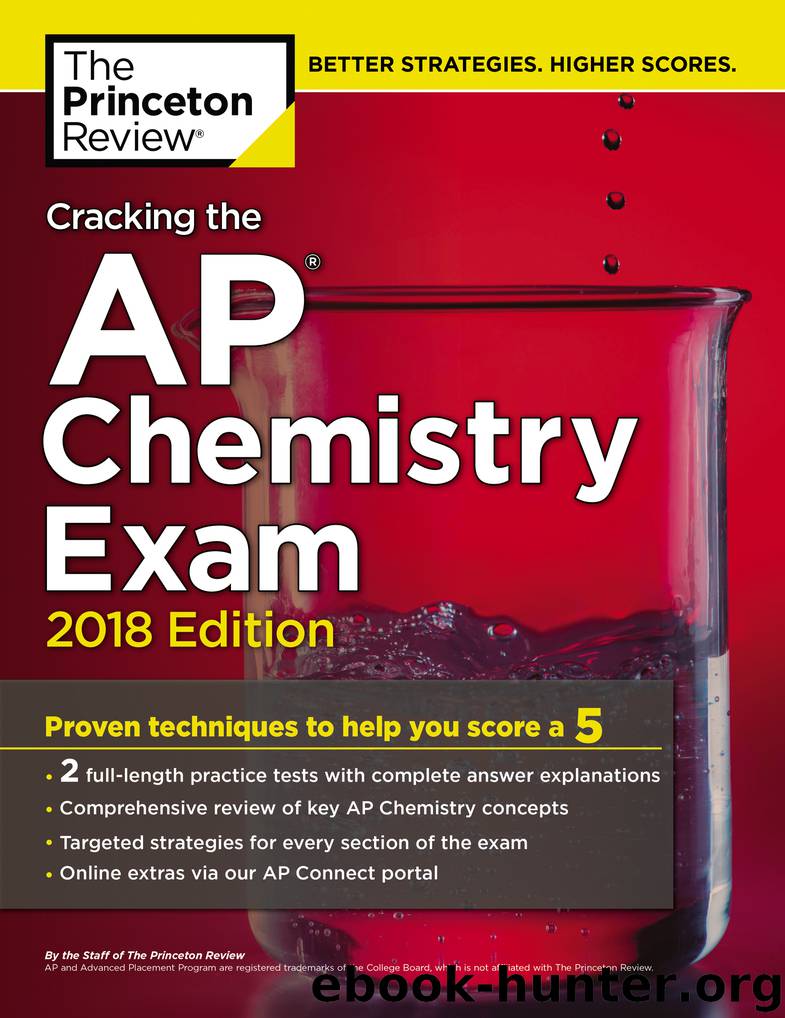Cracking the AP Chemistry Exam, 2018 Edition by Princeton Review

Author:Princeton Review
Language: eng
Format: epub
Publisher: Random House Children's Books
Published: 2017-09-19T04:00:00+00:00
25. B The Pb half-cell has a greater reduction potential than the Cr half-cell. Pb2+ will be able to take electrons from the Cr(s) solution and reduce to become Pb(s).
26. B Cr3+ needs to gain three electrons to reduce into Cr(s), while Mg(s) loses 2 electrons to oxidize into Mg2+. To balance the electrons, the reduction half-reaction must be multiplied by two and the oxidation half-reaction must be multiplied by three in order to have six electrons on each side. The nitrate ion is a spectator and would not appear in the net ionic equation.
27. D As the reaction progresses, Pb2+ is being reduced to create Pb(s). This decreases the amount of positive charge in the solution, which is replaced by the Na+ from the salt bridge. At the anode, excess Cr3+ is being created, which is balanced by the Cl– anions from the salt bridge.
28. A For a reaction to occur, the reduction potential of the ions in solution must exceed the reduction potential for the ions of the corresponding metal. If Cr(s) were placed in a solution containing Pb2+, the Pb2+ would take electrons from the Cr(s) and create Pb(s) and Cr3+.
29. B Oxidation occurs at the anode, and that entails the loss of electrons. As there is no hydrogen gas present in the solution to start, the only substance that can be reduced at the anode is the solid copper itself.
30. A The half-reaction occurring at the anode is 2H+ + 2e- → H2(g), as the only substance present at the beginning of the reaction can that can be reduced is the hydrogen ion (initially, there are no Zn2+ or Cu2+ ions in solution). With copper is being oxidized at the anode, the calculation then becomes (0.00 V) + (–0.34 V) = –0.34 V. That means a voltage differential of 0.34 V will be required for this reaction to occur.
31. C In the initial Cu/Zn cell, as the electrolysis proceeds Cu2+ ions are produced and become part of the solution. The SRP of those ions is greater than that the SRP of H+ ions, so later in the reaction, the Cu2+ is reduced into solid copper at the zinc cathode—this is what causes the copper to plate out on the zinc. If nickel were used as the anode, Ni2+ would be in solution, however, H+ has a higher reduction potential than Ni2+, which means the H+ reduction would continue to occur at the cathode, and no nickel would be plated out of solution.
Download
This site does not store any files on its server. We only index and link to content provided by other sites. Please contact the content providers to delete copyright contents if any and email us, we'll remove relevant links or contents immediately.
Cracking the GRE Premium Edition with 6 Practice Tests, 2015 (Graduate School Test Preparation) by Princeton Review(3596)
ACT Math For Dummies by Zegarelli Mark(3565)
5 Steps to a 5 AP U.S. History, 2010-2011 Edition (5 Steps to a 5 on the Advanced Placement Examinations Series) by Armstrong Stephen(3406)
What It Really Takes to Get Into Ivy League and Other Highly Selective Colleges by Hughes Chuck(3221)
McGraw-Hill's SAT 2014 Edition (Mcgraw Hill's Sat) by Black Christopher & Anestis Mark(3143)
Kick Ass in College: Highest Rated "How to Study in College" Book | 77 Ninja Study Skills Tips and Career Strategies | Motivational for College Students: A Guerrilla Guide to College Success by Fox Gunnar(2720)
Graduate Admissions Essays, Fourth Edition: Write Your Way into the Graduate School of Your Choice (Graduate Admissions Essays: Write Your Way Into the) by Asher Donald(2475)
Get into Any College by Tanabe Gen Tanabe Kelly(2384)
500 Must-Know AP Microeconomics/Macroeconomics Questions(2240)
Easy Algebra Step-by-Step by Sandra Luna McCune(2117)
The Official Guide to the TOEFL Test by ETS(1897)
Open the Gates to the Ivy League: A Plan B for Getting into the Top Colleges by C. W. Henderson(1563)
Cracking the Sat French Subject Test, 2013-2014 Edition by The Princeton Review(1520)
Law School Essays that Made a Difference by Princeton Review(1465)
Cracking the SAT Literature Subject Test, 2013-2014 Edition (College Test Preparation) by Princeton Review(1462)
Barron's AP Calculus by David Bock(1448)
Cracking the AP Physics C Exam, 2018 Edition by Princeton Review(1402)
Barron's SAT Math Workbook by Lawrence S. Leff(1375)
ASVAB AFQT For Dummies by Rod Powers(1319)
